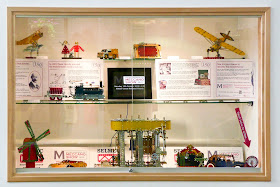 |
| High Five! Click to enlarge! |
Yes I know those two blokes are not Meccano but they are small and they make me smile... We seem to have a fascination with recreating the world around us in miniature. Meccano micro-models are not new, but they have been around for a while. Some of the early manuals have small models but how do we define a micro model? to me, is the use of few parts to achieve something that is instantly recognisable.
 |
| The original old bird? |
At the back end of the 1970s The Transvaal Meccano Guild held a 'Simplicity' model building competition that attracted 25 entries
I know that a bulldozer won the competition but the short piece in Meccano Magazine, April 1979 (Page 69) only described the driver being made from handrail knobs and rod and strip connectors. however there is a plan of the little bird (that we call a chicken). We have built the little fellow several times and now hide one inside our bigger models for a bit of fun.
In recent years Meccano themselves have even produced a series of micro-models that called 'Nano' kits.
The helicopter, that I have mentioned before on the blog, is just one of six little models that was added to, at the end of their year of release, by a small Nano robot sold exclusively through Marks & Spencer.
 |
| Modern Micros |
I found the little cat on the VirtualMec website where unfortunately, due to the odd missing part in the VirtulMec parts inventory, the poor little fellow has no head!
Recently I built a micro-model of the USS enterprise ( See
HERE ). To my surprise a couple of other people built models too. My friend and fellow South East London Club member, Chris Fry, arrived here last Sunday clutching his version, complete with a few
enhancements.
 |
| Chris Fry's 'improved' version |
 |
| Pauli's version |
It was not long before the craze became global and fellow
Rusty, Pauli, posted his version on the Rust Bucket forum. With his permission I reproduce it here and as he did not feel the need to
enhance it I guess the original design wins out - Only kidding, Chris!
So what next? There is an existing micro-models website that has been dormant for years. The owner has rebuilt many of the models from Meccano Magazine articles, including the bird, and photographed them. I did contact the owner at one point and he said that his interest has waned which is why it has just sat there. It is worth a look. You will find the site
HERE. How about a few more modern models?
 |
| My version is cordless! |
At the moment there is a Meccano enthusiast following the original Frank Hornby concept of building what he sees around him from the limited selection modern parts available to him. His name is Subrata Ghoshal he lives a remote Himalayan corner of India, and he produces superb contemporary models usually with very limited parts. One of his recent micro-models was of an electric power drill. I decided to copy his design and build my own version, mine being cordless! Those of you who are followers of Rust bucket and/or the Spanner II list will be familiar with Subrata's work. if you are not then check out his gallery on the NZ meccano website
HERE You will be amazed at his incredible creativity. You will never be able to complain that you have not got enough Meccano again.
To finish off this post here are a couple of models from our old files that were build for a purpose but at the time were not tough of (by us) as micro-models, the first is a small train we built to make a huge 16ft long model of the Forth Bridge look a bit more inserting, the train stole the show as everybody looked straight through the bridge at the train inside.
 |
| Heading South over the Forth Bridge |
And to celebrate Sue's interest in flowers and to keep up with here exhibits at the Chelsea flower show I built her a flower arrangement of my own, using a minimum parts.
 |
| First prize at Chelsea next year? |
|
Miniature and micro models are a great distraction for building huge models but don't be surprised if other do not understand you efforts. On showing my elderly mother our micro-model 'Chicken' all she said was "All that stuff and all you built was that?"
Ralph.
















































